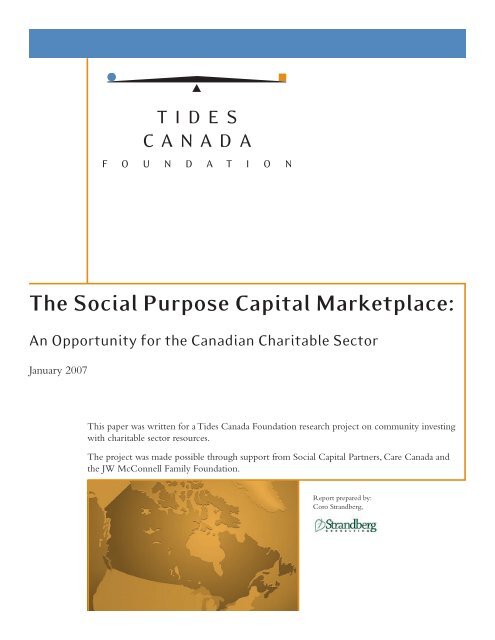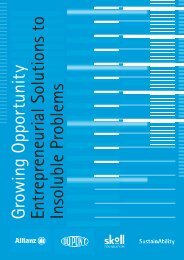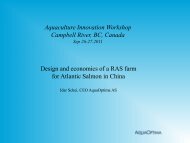The Social Purpose Capital Marketplace - Tides Canada Foundation
The Social Purpose Capital Marketplace - Tides Canada Foundation
The Social Purpose Capital Marketplace - Tides Canada Foundation
You also want an ePaper? Increase the reach of your titles
YUMPU automatically turns print PDFs into web optimized ePapers that Google loves.
<strong>The</strong> <strong>Social</strong> <strong>Purpose</strong> <strong>Capital</strong> <strong>Marketplace</strong>:<br />
An Opportunity for the Canadian Charitable Sector<br />
January 2007<br />
This paper was written for a <strong>Tides</strong> <strong>Canada</strong> <strong>Foundation</strong> research project on community investing<br />
with charitable sector resources.<br />
<strong>The</strong> project was made possible through support from <strong>Social</strong> <strong>Capital</strong> Partners, Care <strong>Canada</strong> and<br />
the JW McConnell Family <strong>Foundation</strong>.<br />
Report prepared by:<br />
Coro Strandberg,
THE SOCIAL PURPOSE CAPITAL MARKETPLACE:<br />
AN OPPORTUNITY FOR THE CANADIAN CHARITABLE SECTOR<br />
Compiled By:<br />
Coro Strandberg<br />
January 2007<br />
Acknowledgements<br />
<strong>The</strong> following people have reviewed and provided comments on the paper. <strong>The</strong>ir time and contributions are<br />
appreciated.<br />
• Priscilla Boucher, Assiniboine Credit Union<br />
• Rupert Downing, Canadian Community Economic Development Network<br />
• Tim Draimin, <strong>Tides</strong> <strong>Canada</strong> <strong>Foundation</strong><br />
• Andres Dussan, Ashoka<br />
• Derek Gent, Vancity <strong>Capital</strong> Corporation<br />
• Scott Hughes, Vancity Credit Union<br />
• Carol Hunter, Canadian Co-operative Association<br />
• Laird Hunter, Worton Hunter & Callaghan<br />
• David LePage, Enterprising Non-Profits<br />
• Nancy Neamtan, Chantier de l’Economie <strong>Social</strong>e<br />
• George Scott, Vancity Credit Union<br />
• Kathleen Speakman, <strong>Social</strong> Venture Partners<br />
• Walter Ross<br />
• Arthur Wood, Ashoka<br />
• Bill Young, <strong>Social</strong> <strong>Capital</strong> Partners<br />
2
Executive Summary<br />
<strong>The</strong>re is growing interest in the opportunity of scaling up social finance in <strong>Canada</strong>, as a means to foster social<br />
innovation and leverage additional capital to advance the social and environmental quality of life. This paper<br />
compiles recent thinking on the opportunity of creating a social capital marketplace, with a focus on the role<br />
of charitable organizations, both as financiers and recipients of social finance capital. It defines the social capital<br />
marketplace within the Canadian context, and lists a number of key drivers and trends towards its creation, from the<br />
capital provider, the capital user and the intermediary point of view. <strong>The</strong> trends analysis concludes that significant<br />
capital could potentially be available to finance social innovation given the current and anticipated influx of new<br />
wealth donors and socially motivated investors, and a venturesome approach to philanthropy and social development<br />
is growing amongst this new donor and investment community. Additional trends noted in the scan include the<br />
growth in the social enterprise sector, and the considerable social finance experimentation that is underway in<br />
<strong>Canada</strong> and globally.<br />
<strong>The</strong> paper next describes the extent and nature of the Canadian charitable sector, using Statistics <strong>Canada</strong> data,<br />
concluding 1) that the charitable sector already derives considerable revenues from its fee-generating activities (i.e.<br />
fees for goods and services) and 2) that the sector is asset-rich, holding considerable wealth that could be leveraged<br />
for social innovation. <strong>The</strong> paper goes on to list a number of barriers and opportunities for the growth of the social<br />
finance sector, which collectively point to a road map for taking it to scale:<br />
• Map and build out the social purpose capital market infrastructure<br />
• Promote human capital development for social financiers and entrepreneurs<br />
• Develop and implement education, awareness and engagement strategies for capital providers<br />
• Expand capacity-building for capital users<br />
• Construct and advocate for a social finance public policy agenda<br />
<strong>The</strong> paper concludes as it started, with a proposition that mission-based organizations are positioned to leverage<br />
their under-performing assets to scale up social innovation and social finance in <strong>Canada</strong>.<br />
1. Introduction<br />
<strong>The</strong> past few years have witnessed significant transformation in the community sector in <strong>Canada</strong>, with declining<br />
government revenues and the emergence of new wealth donors, venture philanthropy, hybrid social enterprises (i.e.<br />
non-profit businesses, earned income programs, and social purpose for-profits), social programming innovations and<br />
social finance experiments. <strong>The</strong>se trends position the sector – including social economy and community economic<br />
development organizations, foundations using their assets to invest in community development, philanthropic<br />
and community investors, social venture businesses, etc. – for increased scale and impact, with great potential, if<br />
successful, to generate significant long term social, economic and environmental benefits to Canadian society.<br />
3
<strong>The</strong> hybridization of social and environmental mission with business enterprise is a global trend, the speed and<br />
impact of which is greatly dependent on the degree to which financing is available to capitalize the emergent<br />
hybrid ventures. Neither purely for-profit (a sector financed through traditional capital markets), nor purely notfor-profit<br />
(financed by donors and governments), the social enterprise sector struggles for legitimacy and impact<br />
through a lack of financial instruments and intermediaries that recognize and reward the dual purpose nature of the<br />
business. <strong>Canada</strong> lacks a sophisticated and integrated “social purpose capital marketplace” to provide the critical<br />
financing to bring these social value businesses to scale and to realize their potential. It is the position of this paper<br />
that if a means can be found to unlock both traditional capital within the banking system and, particularly, the<br />
latent capital within the foundation sector a significant volume of new funding can be freed up to finance a new<br />
generation of social enterprises.<br />
<strong>Tides</strong> <strong>Canada</strong> <strong>Foundation</strong> and PLAN Institute convened two events over the past 18 months 1 , attended by a<br />
diverse mix of business, finance and investment, government, social innovation, hybrid social venture representatives<br />
and others, to address the potential, opportunities and barriers of a social purpose capital marketplace to advance<br />
social transformation. Both sessions concluded resoundingly that greater education and awareness and partnerships<br />
between the business, finance and community sectors is critical to move this agenda forward. <strong>The</strong>y also concluded<br />
that there is a need for more information on international best practices, demonstration pilots and measurement<br />
models such as a social return on investment. Finally, they agreed that the development of a public policy program<br />
to facilitate the growth of social finance is essential. Across both meetings participants called for a national effort<br />
to develop a strategic plan to create the architecture for a social purpose capital marketplace in <strong>Canada</strong>. It was<br />
recognized that to move public policy and business innovation forward, it was critical to scope out the nature of<br />
the Canadian social purpose capital marketplace. This paper is an attempt to do just that, written for <strong>Tides</strong> <strong>Canada</strong><br />
<strong>Foundation</strong> and funded with support from CARE <strong>Canada</strong>, JW McConnell Family <strong>Foundation</strong>, and <strong>Social</strong> <strong>Capital</strong><br />
Partners, all organizations interested in supporting the growth of the social finance sector in <strong>Canada</strong>.<br />
<strong>The</strong> following provides an overview of the social purpose capital marketplace, including a definition, drivers<br />
and trends, and the size and scale of the Canadian charitable sector – both financiers and beneficiaries of a social<br />
finance industry. <strong>The</strong> paper goes on to identify barriers and gaps to, and opportunities for, growing social finance<br />
in <strong>Canada</strong>, concluding with some thoughts on ways to advance the creation of a Canadian social purpose capital<br />
marketplace including possible roles for the charitable sector. <strong>The</strong> focus of the paper on charities is intentional,<br />
insofar as <strong>Tides</strong> <strong>Canada</strong>, the paper sponsor and itself a registered charity, seeks to understand and promote the<br />
unique perspective of charitable organizations with respect to these growing trends. As such the paper does not<br />
address other social enterprise structures including non-profit organizations, co-operatives and for-profit social<br />
enterprises which are significant contributors to the social economy.<br />
<strong>The</strong> paper summarizes perspectives gleaned from key articles written on this topic, as noted in the resource list in<br />
Appendix A. <strong>The</strong> author rolled up the research and insights from a number of sources into this paper, and organized<br />
them to address the question of the role of the charitable sector in scaling up the social finance sector. Thus, not all<br />
of the language is original and quotes have been used to identify key sources throughout the paper. Additionally,<br />
the paper underwent a peer review, in which comments were solicited from social finance practitioners and thought<br />
leaders in the field, listed under “Acknowledgements” above.<br />
<strong>The</strong> emergent and transitional nature of the social finance sector makes it difficult to capture all the issues and<br />
contradictions inherent in its growth, a point that was realized through the peer review process. <strong>The</strong> exercise to<br />
1 Coro Strandberg, “Over the Horizon” (http://www.tidescanada.org/files/pdf/over_horizon.pdf)<br />
4
define, assess and scale social finance is necessarily iterative – considerable scoping work lies ahead to perceive the<br />
boundaries and opportunities of this effort. Some questions that this paper does not fully address and will no doubt<br />
be tackled in future forums, include:<br />
• <strong>The</strong> extent and nature of the demand for social finance, i.e. documented evidence and quantification of social<br />
enterprise capital needs;<br />
• <strong>The</strong> extent and nature of the market for moderate return, longer term, or higher risk investments;<br />
• <strong>The</strong> degree to which the social sector would be interested in collaborating to grow their social finance<br />
opportunities, and evidence thereof;<br />
• <strong>The</strong> appropriate role for the public sector versus social enterprises in the provision of social goods; and<br />
• Whether regulatory rather than voluntary approaches should be advanced for motivating social outcomes<br />
through capital markets.<br />
This paper begins by examining the definition of the social purpose capital marketplace, and identifying some of<br />
the key drivers and trends of its development. It goes on to define and quantify the Canadian charitable sector, and<br />
then lists the barriers and opportunities to growth of the social marketplace, laying out a possible roadmap to take<br />
social finance to scale.<br />
2. <strong>Social</strong> <strong>Purpose</strong> <strong>Capital</strong> <strong>Marketplace</strong> Defined<br />
<strong>Social</strong> historians will debate the origins of the social purpose capital marketplace, but it could be argued that<br />
Bangladesh is the birthplace of the modern social purpose capital market, wherein the Grameen Bank pioneered<br />
the micro-finance movement, proving that it was financially viable to make very small loans to impoverished<br />
women to finance family micro-businesses. Some define the social purpose capital marketplace in very broad<br />
terms as the market within which non-profit organizations seek and receive financial support from a variety of<br />
donors, contracts, government grants and other sources 2 . For the purpose of this paper, the social purpose capital<br />
marketplace is defined as the space on the financial continuum between high financial value and no social value<br />
returns (traditional financial investment vehicles) and no financial value but high social returns (grants).<br />
Financial products in this zone (referred to as social finance products) include insured and uninsured deposits, senior<br />
and subordinated loans, debt-with-equity features, loan guarantees, fixed income securities, real estate mortgages,<br />
stock purchases and private equity. What distinguishes these investments as social finance is that they are generating<br />
a social (and/or environmental) as well as a financial return, referred to as a double bottom line or blended value<br />
investment (or a triple bottom line investment when social, economic and environmental returns are generated).<br />
<strong>The</strong>y exist on the spectrum between the +5% return of a conventional fixed income investment and the -100%<br />
return characteristic of grants. Also found along this spectrum are financial investments which offer the investor<br />
below market returns, while others offer market rates and everything in between.<br />
<strong>The</strong> social purpose capital marketplace channels financing to social purpose ventures unable to secure capital<br />
through traditional sources and often as a stepping stone to conventional finance. <strong>The</strong>se social ventures collectively<br />
2 Jed Emerson and Paul Carttar, Money Matters: <strong>The</strong> Structure, Operations and Challenges of Nonprofit Funding, Jan. 2003, p. 7.<br />
5
make up the social economy, which the Federal Government defines 3 as enterprises producing goods and services<br />
for the market economy, as with any business, but where their operations are managed and their surpluses directed<br />
in the pursuit of social and community goals. <strong>Social</strong> enterprises are structured to:<br />
o stimulate job creation and skills development;<br />
o enhance community capacity for social supports;<br />
o support economic growth and neighbourhood revitalization;<br />
o protect and regenerate the environment;<br />
o improve social capital (here in the context of trust and reciprocity per Robert Putnam); and<br />
o mobilize disadvantaged groups.<br />
<strong>The</strong>y could be for-profit subsidiaries of non-profit organizations, designed to generate a revenue stream to finance<br />
social programs, or they could be non-profit structures with a mission to provide benefits and employment to<br />
disadvantaged groups and sectors including community loan funds and conservation financing. Asset development<br />
initiatives of non-profits such as buying buildings and creating endowments and for-profit businesses with overarching<br />
social and environmental goals are included within the social enterprise sector.<br />
Fundamentally, the social purpose capital marketplace mirrors the traditional capital market system, the means<br />
by which long-term debt and equity securities are bought and sold by companies, governments and other<br />
organizations either directly or through intermediaries. For the efficient functioning of social purpose capital<br />
markets, the social finance industry needs to replicate or infuse the infrastructure of traditional finance, which<br />
has been evolving for the past few hundred years. While the lack of financial sophistication poses an obvious<br />
developmental challenge to the social finance sector, the pre-existing architecture of the financial capital<br />
marketplace provides a useful roadmap for scaling up social finance for social innovation in <strong>Canada</strong>. Further, other<br />
jurisdictions, particularly the US, have more advanced social purpose capital markets, as reviewed in the drivers and<br />
trends below. <strong>The</strong>ir more mature social finance industry provides a template and best practice database which can<br />
be readily built upon for the benefit of the Canadian social enterprise sector.<br />
As demonstrated by the Bangladesh-based Grameen Bank illustration that heads this section, social finance can<br />
flourish anywhere under the right market conditions. Indeed, a Canadian social capital marketplace can raise<br />
financing for either domestic purposes or for Canadian-led development efforts overseas.<br />
3 http://www.sdc.gc.ca/en/cs/comm/sd/social_economy.shtml<br />
6
Drivers and Trends of the <strong>Social</strong> <strong>Purpose</strong> <strong>Capital</strong><br />
3. <strong>Marketplace</strong><br />
<strong>The</strong>re are three main actors in the social purpose capital marketplace which are driving its emergence and<br />
positioning it for growth: capital providers, capital users and the intermediaries and brokers of capital. Collectively<br />
these actors are transforming the landscape of non-profit finance.<br />
<strong>Capital</strong> Provider Trends:<br />
• New wealth and venture philanthropy<br />
A new breed of capital providers – donors and investors – are entereing the scene and influencing the development<br />
of the social purpose capital marketplace. Rapid wealth creation on a global scale produced 691 billionaires by<br />
2005, a nearly 65% growth from the previous decade. 4 Much of the new wealth is self-made, from innovators in<br />
the traditional private sector, whose approach to philanthropy is more businesslike and who are seeking resultsbased<br />
impacts or social returns on their investments. This emerging field of philanthropic investment, referred to<br />
as venture philanthropy, applies the practices of long-term engaged investment of venture capital models in the<br />
for-profit sector to the development and financing of social purpose enterprise. This includes not only financial<br />
investment, but technical assistance and capacity building, multi-year and tailored financing, and shared risk. 5<br />
Indeed, venture philanthropy is highly risk-oriented, unlike traditional foundation and government grant funding<br />
which is risk adverse. <strong>The</strong>se venture philanthropists are hoping that the market discipline they bring to their social<br />
investments will result in a productivity revolution in the social sector, helping the sector achieve scale, durability<br />
and impact. Venture philanthropy is moving the donor community away from transactional or cheque-book giving,<br />
towards transformational investment approaches.<br />
<strong>The</strong> impact of this shift is expected to be significant with the anticipated intergenerational transfer of wealth<br />
predicted over the coming decades. While statistics are lacking for <strong>Canada</strong>, US estimates are that baby boomers<br />
and their parents will transfer wealth and other assets worth at least US $41 trillion dollars to family members and<br />
charities over the next 50 years. 6 In <strong>Canada</strong> there is a rumoured one trillion dollars, although some analysts believe<br />
that, based on the average of less than one percent of annual wealth that shifts between Canadian generations each<br />
year, the amount is actually closer to $200 billion than $1 trillion. 7<br />
• Growth of the socially responsible investment sector<br />
Both Canadian and US socially responsible investment (SRI) sectors are growing considerably, in the US<br />
particularly. <strong>The</strong>re is an estimated $3 USD trillion in SRI assets globally 8 within funds that integrate social and<br />
environmental considerations, conduct shareholder advocacy on social, environmental and governance concerns,<br />
and make community investments to advance local development. As the Canadian <strong>Social</strong> Investment Review<br />
reported 9 , as of 2004 there were $65.46 CDN B in SRI investments, up 31% from 2000, of which $546 M is found<br />
within the community investment (CI) sector, including investments that finance poverty alleviation, community<br />
4 <strong>The</strong> Economist, A Survey of Wealth and Philanthropy, p. 3.<br />
5 NESsT definition at http://www.nesst.org/<br />
6 Boston College Centre on Wealth and Philanthropy: http://www.lexisnexis.ca/about/releast_details.php?id=36<br />
7 See: http://en.50plus/display.cfm?documentID=7500&CabinetID=329&LibraryID=104<br />
8 See: http://www.thebanker.com/news/fullstory.php/aid/465/Encouragement_for_emerging_markets_.html<br />
9 See: http://www.socialinvestment.ca/publications.htm<br />
7
and co-operative development and environmental regeneration and conservation. In contrast to the Canadian CI<br />
sector, the US has witnessed an explosion of community investing over the past decade, testament to the impact<br />
focused efforts to scale the social finance sector can have. <strong>The</strong> recent 10 year review of community investing trends<br />
in the US, compiled by the US <strong>Social</strong> Investment Forum 10 , revealed that since 1995 community investment has<br />
grown from $4 billion USD in assets to $19.6 billion USD in 2005, a growth of 388%. This phenomenal growth<br />
is attributable to the increased number and capacity of community finance intermediaries, improved information<br />
architecture, government tax incentives, and public education and awareness of the community investment<br />
opportunities, all of which are on the radar of social finance professionals in <strong>Canada</strong>.<br />
Additionally, the US Community Reinvestment Act, which compels American financial institutions to contribute<br />
to community development finance, has played a big part in the ongoing growth of the American community<br />
investment sector.<br />
It is anticipated that these community investment trends will manifest among mission-based organizations and asset<br />
managers such as foundations, churches and asset-rich non-profits such as hospitals, educational institutions and<br />
others. While the Canadian CI markets have been slow to evolve in this space, developments south of the border<br />
are promising.<br />
• Mission-Based Investing<br />
Mission-based investing is the incorporation of an institution’s mission into its investment decision-making process,<br />
where the organization’s mission statement serves as a guide in determining what, if any, non-financial objectives it<br />
may set for its portfolio. Mission-based organizations that seek to improve societal or environmental conditions are<br />
waking up to the opportunity of using their assets in a more engaged way, an approach referred to as total capital<br />
asset management 11 .<br />
<strong>Foundation</strong>s, particularly, can benefit from this perspective. Canadian foundations allocate a minimum of 3.5%<br />
of their capital in pursuit of their entire social mission through grants, while 96.5% of capital assets are managed<br />
in pursuit of financial value, with typically 0% consideration of social mission. This bifurcation of goals can be<br />
addressed by a “unified investment strategy” (UIS) 12 , defined as an investment strategy that makes use of both<br />
philanthropic and core asset investments to maximize the blended value of those investments. A UIS views grants,<br />
below market-rate loans and market-rate investing as various tools to be used in the pursuit of a single value<br />
proposition – one that seeks to maximize economic, social and environmental value across all the organizational<br />
bottom lines. In this approach, investors view their overall investment portfolio as a single body of investments<br />
– not simply as financial investments on the one hand and charitable gifts on the other.<br />
In the US, a number of foundations (with a disbursement quota of 5% as compared to <strong>Canada</strong>’s 3.5%) are adopting<br />
asset allocation strategies that set targets or caps for investing their endowments in double bottom line investments,<br />
ranging from 1 – 3 % for large foundations to up to 40% of assets for smaller more entrepreneurial foundations. 13<br />
<strong>The</strong>se investments can be below market loans or loan guarantees or equity investments (e.g. stock purchases in<br />
social purpose businesses and partnership stakes in community venture capital and micro-finance funds) 14 . Called<br />
Program-Related Investing, or PRIs, this approach to investing is relatively small in the US, but growing. Research<br />
10 See: http://www.communityinvest.org/<br />
11 See: http://www.blendedvalue.org/publications/additional.html<br />
12 See Jed Emerson. “A <strong>Capital</strong> Idea” for a discussion of Unified Investment Strategy methods<br />
13 Mark Kramer and Sarah Cooch, Investing for Impact, p. 4.<br />
14 Neil Carlson, Program-Related Investing Skills and Strategies for New PRI Funders, p.2<br />
8
y the US <strong>Foundation</strong> Centre which undertakes periodic surveys of program-related investment reveals that in<br />
2003 255 foundations were active in PRIs, compared to over 61,000 foundations active in the US that year 15 .<br />
However, PRI-invested foundations report myriad benefits of PRI investing and efforts are underway to scale<br />
up PRI approaches in the US, suggesting likely growth in this field over the coming decade. Benefits of PRI<br />
programming include:<br />
• the opportunity of using a new set of tools to achieve impact (e.g. PRIs can stimulate business-based solutions<br />
to social problems, especially where a grant is an inappropriate intervention);<br />
• an ability to access funds beyond the normal grant budget (both principal and income can work for charitable<br />
ends, while a PRI can also leverage other financing);<br />
• ability to preserve foundation assets by “recycling” funds (grants pay-outs are lost to the foundation while PRIs<br />
return the capital); and<br />
• asset diversification, where PRIs can be used to reduce portfolio volatility or increase investment returns 16 .<br />
Additionally, while grant contributions can create recipient dependency, PRI investing can foster the internal<br />
capacity of borrowers required to build up their financial and management skills while also enabling asset<br />
acquisition of organizations to secure longer term sustainability. (<strong>The</strong> regulatory environment for Canadian<br />
foundations differs from the American system in that US charity rules permit a broader interpretation of charitable<br />
purposes allowing for more innovation in the areas where charities are appropriating market mechanisms for public<br />
benefit. Thus the US has a much more developed social finance universe with a broad range of enabling programs<br />
supported by foundations and individual philanthropists. Other reasons account for these differences including a<br />
more entrepreneurial environment and lower non-profit dependence on government funding in the US.) 17<br />
While there are many practical benefits of program-related investing, it is perhaps values-alignment which will be<br />
the biggest driver of capital into the social venture sector as more and more mission-driven asset-rich organizations,<br />
including foundations, churches, non-profits, hospitals, universities, unions, SRI mutual funds, credit unions and<br />
others see community investment as a high impact social change tool. For these opportunities to be realized,<br />
however, social purpose capital users will need to scale up their operations and capacities and a social finance<br />
industry will need to be developed.<br />
Other sectors, too, are poised to consider a role in double bottom line investing, including Canadian pension funds,<br />
collectively holding over $700 billion in assets, religious organizations, First Nations organizations, universities, and<br />
non-profits themselves.<br />
<strong>Capital</strong> User Trends:<br />
• Growth of <strong>Social</strong> Enterprises<br />
<strong>Social</strong> enterprises, which pursue social and financial goals, are an emergent sector in <strong>Canada</strong> and internationally.<br />
Sometimes referred to as the social economy sector, there have been recent efforts to define and quantify the size<br />
and scale of the industry. In Quebec, for example, there are over 6,200 social economy enterprises that together<br />
employ 65,000 people and generate annual sales in excess of $4 billion 18 . A 2003 study identified over 3,000<br />
15 Margaret Bolton, <strong>Foundation</strong>s and <strong>Social</strong> Investment, p. 9.<br />
16 Kramer and Cooch, p. 4.<br />
17 See: http://www.cra-arc.gc.ca/E/pub/tg/rc4143/rc4143-e.htm#P426_50299<br />
18 Nancy Neamtan and Rupert Downing, <strong>Social</strong> Economy and Community Economic Development in <strong>Canada</strong>, p. 9.<br />
9
community-based organizations involved in community economic development, combining social and economic<br />
development activities within <strong>Canada</strong> 19 . <strong>Social</strong> enterprises are not a new form of endeavour: for years museums<br />
and art galleries have operated gift shops to support their programs, others such as the YMCA and YWCA charge<br />
fees to support their charitable activities, while thrift stores generate revenues and provide low-cost client goods.<br />
According to the Enterprising Non-Profits Program in BC, a financing and resource centre for social enterprises,<br />
there are three major reasons why non-profits and charities have started enterprises in recent years 20 :<br />
• diminished government funding;<br />
• the understanding that there are some needs the market will never meet on its own; and<br />
• the opportunity to advance mission-related goals.<br />
Additional reasons include the need to augment funding to meet growing societal needs and the desirability of<br />
diversifying funding to reduce dependence on individual funders.<br />
<strong>The</strong> decade has also witnessed increased financing and capacity-building programs for the social enterprise sector,<br />
of which the Enterprising Non-Profits Program is a prime example. <strong>The</strong> Federal Government brought attention to<br />
the sector in its 2004 Budget 2004 when it announced $132 million for initiatives to support the social economy,<br />
including research, capacity building financing and improved access of social enterprises to programs and services<br />
for small- and medium-sized enterprises. 21 While it is unclear if the current Federal Government will maintain<br />
this focus, nonetheless, the sector stands to gain from this increased attention. Globally the social enterprise sector<br />
is experiencing considerable interest both as an antidote to globalization, where economic determination is vested<br />
locally, and as an anti-poverty and environmental regeneration tool. For example, several OECD countries have<br />
developed strategies to promote social enterprises and the European Union includes the social economy in its<br />
entrepreneurship pillar. Major foundations including Ashoka and Skoll are investing heavily in advancing the<br />
growth and prospects of the social enterprise sector.<br />
• Cost of <strong>Capital</strong> Allocation<br />
Another driver of the move to social enterprise development, as a means of advancing social mission, is the growing<br />
awareness of the cost of capital allocation. Recent research in the US and UK has highlighted the problematic<br />
nature of current fund-raising practices and relationships which can be as high as 50% 22 compared to rates as low as<br />
2 and 3% in conventional finance. Looked at as an investment market, the social purpose capital marketplace is ten<br />
times less efficient structurally. As these ironies are better understood and the gaps closed, intermediaries offering<br />
brokerage in the social purpose capital markets will grow apace.<br />
Infrastructure and Intermediary Trends:<br />
• Investment Infrastructure<br />
In order for the social purpose capital marketplace to achieve scale and realize the benefits of social enterprise,<br />
investment infrastructure will need to be established to support its growth. <strong>The</strong>re is a nascent discussion underway<br />
in the Canadian CED and social enterprise/economy communities, which is part of a global dialogue amongst the<br />
SRI investment industry, the World Economic Forum, the micro-finance sector and others looking to bridge this<br />
19 Ibid., p. 10.<br />
20 See: http://www.enterprisingnonprofits.ca/<br />
21 See: http://www.sdc.gc.ca/en/cs/comm/sd/social_economy.shtml<br />
22 Arthur Wood and Maxmillian Martin, Market-Based Solutions for Financing Philanthropy, p. 2.<br />
10
gap. It is expected that the coming decade will see rapid expansion of this infrastructure, including social stock<br />
exchanges, social investment banks and asset management, private banking, brokerage and distribution channels,<br />
consulting, data services and research houses.<br />
• <strong>Social</strong> Finance Instruments<br />
Similarly, considerable research and experimentation is underway in the development of blended value financial<br />
instruments, which replicate the features of conventional products with an embedded social value component.<br />
Various risk/return considerations of different investor segments from fiduciaries to high-net worth individuals<br />
will be incorporated into the development of diverse sectoral and geographic community investment opportunities<br />
leveraging a range of social and environmental outcomes.<br />
In order to better understand the opportunities ahead for the growth of a thriving Canadian social purpose<br />
capital marketplace it would be informative to consider the size and scale of the charitable sector in <strong>Canada</strong>,<br />
significant prospective investor and investee communities poised to launch a new generation of social innovation.<br />
<strong>The</strong> charitable sector (both granting foundations and operating charities) has a key role on the frontlines of<br />
innovation, as an “R & D” incubator for practical ways that society can meet and overcome evolving challenges in<br />
the social and environmental arenas. <strong>Social</strong> finance is increasingly recognized as a needed adjunct to other sources<br />
of charitable funding (such as receipted donations, which only account for 6% of charities revenue), in order for<br />
charities to enhance their impact and sustainability.<br />
4. Canadian Charitable Sector Description<br />
Canadian charities and non-profit, voluntary organizations are amongst the primary beneficiaries and financiers<br />
of the social purpose capital marketplace. To realize the potential of this sector to advance the development of the<br />
social marketplace, it is important to have an understanding of the nature of the sector itself.<br />
Nature of the Charitable Sector:<br />
Non-profit and voluntary organizations are defined as organizations that meet the following criteria:<br />
• Non-governmental<br />
• Non-profit distributing<br />
• Self-governing<br />
• Voluntary (benefit to some degree from voluntary contributions of time or money)<br />
• Formally incorporated or registered under specific legislation 23 .<br />
Registered charities include places of worship (the largest category of charities), social services organizations, health<br />
and health care organizations such as hospitals, private and public foundations and teaching institutions (e.g. colleges<br />
and universities).<br />
23 Statistics <strong>Canada</strong>, Cornerstones of Community.<br />
11
Scale of the Charitable Sector:<br />
Recent federal surveys of the non-profit and voluntary sector documented 82,000 charities from a total pool of<br />
161,000 non-profit and voluntary organizations. 2003 revenue of Canadian charities totalled $70 B, 18% of which<br />
is in gifts and donations, or $12.6 B; 16.3% of which is fees for goods or services ($11.4 B), the latter providing an<br />
indication of the entrepreneurial nature of the charitable sector. 54.0% of charitable revenue is from government,<br />
including payments for goods and services and grants and contributions 24 . Overall charitable sector assets are<br />
deemed to be in the order of $100 B, indicative of the collective wealth that could be levered for greater social<br />
change and innovation with the right stimulus in place.<br />
Scale of the <strong>Foundation</strong> Sector:<br />
<strong>The</strong>re were 8,954 registered foundations in 2005 (less than 1/3 are active), with $13.8 B in combined assets<br />
(2005) 25 . In 2003, nonprofits and voluntary organizations, including charities, received $1.1 B from fundraising<br />
organizations, family and public foundations, little more than one percent of the revenues of the charitable sector 26 .<br />
It is one of the purposes of this paper to pose the question as to how foundation assets can be mobilized to<br />
generate higher social benefits. From a total capital asset management point of view, how can Canadian foundation<br />
assets be engaged to work harder? Currently these endowments are organized along a single bottom line which<br />
is to generate financial returns on the portfolio. Looked at from a double or triple bottom line perspective, and<br />
considering the trends and drivers for a more active social purpose capital market described in this paper, how can<br />
social and environmental returns be created in addition to financial returns? As can be seen from the foregoing<br />
analysis, there is an over-dependence on a relatively small set of funders, thus external factors such as government<br />
cuts and policy changes can have a disabling impact on the social sector. How can the social sector isolate itself<br />
from these factors, increase the range of financing options available to it and foster an innovation and results-based<br />
culture for greater social impact, scale and durability?<br />
<strong>The</strong> balance of this paper will turn to discussing the barriers to, and opportunities for, scaling up the Canadian<br />
social purpose capital marketplace, with a focus on the role of the charitable sector.<br />
24 Statistics <strong>Canada</strong>, p. 28.<br />
25 See: Philanthropic <strong>Foundation</strong>s of <strong>Canada</strong>, http://www.pfc.ca/<br />
26 Statistics <strong>Canada</strong>, p. 27.<br />
12
Barriers to <strong>Social</strong> <strong>Purpose</strong> <strong>Capital</strong> <strong>Marketplace</strong><br />
5. Growth<br />
<strong>Canada</strong> lacks a dynamic and efficient social purpose capital market to create new sources of income and increase<br />
overall financing to enable the community sector to take social innovation to scale. <strong>The</strong> following are some of the<br />
key barriers faced by capital providers and users and the intermediation gaps to advancing social finance in <strong>Canada</strong>.<br />
<strong>Capital</strong> Provider Barriers:<br />
<strong>Capital</strong> providers – those with capital to invest in community development, whether individuals or asset managers<br />
– confront the following barriers to their participation:<br />
• Low awareness: there is an overall lack of awareness and understanding regarding community investment<br />
opportunities on the part of potential investors.<br />
• Poor information: the prevailing belief amongst potential community investors is that all CI investments are<br />
concessionary and high risk.<br />
• Risk and return issues: the CI sector lacks a track record and the relation between risk and various returns<br />
is unclear. <strong>The</strong> sector struggles with poor risk mitigation and low returns, a result of its under-capitalization<br />
and lack of operating capacity.<br />
• High transaction costs: the sector’s small deal size results in higher transaction costs – products that require<br />
special handling result in slow adoption.<br />
• Limited financial proposition: a charitable tax deduction is the only financial value proposition available<br />
to individual donors wishing to invest in social enterprises. While there are tax incentives for other sectors,<br />
such as labour-sponsored venture capital funds, film and oil and gas, the social enterprise sector does not enjoy<br />
similar tax credit status.<br />
<strong>Capital</strong> Provider Barriers Specific to the <strong>Foundation</strong> Sector:<br />
<strong>The</strong> following are some barriers foundations confront when contemplating social enterprise investments:<br />
• Regulatory and fiduciary issues: uncertain regulatory and fiduciary mandates for double bottom line<br />
investments, including a lack of trustee education and awareness.<br />
• Cultural issues: foundations place a heavy emphasis on start-up and innovation funding rather than longterm<br />
sustainability and capacity development of non-profits. <strong>The</strong>ir primary focus is on project and program<br />
financing as opposed to organizational development, with a one-size-fits-all mentality: the grant as the sole<br />
means of program financing.<br />
• Staff resources: foundation staff lack the dedicated resources, time, skills and expertise to engage in social<br />
enterprise finance. <strong>The</strong>re are few resources and tools available in <strong>Canada</strong> to promote CI or PRI roles to<br />
foundations and their leadership.<br />
13
Infrastructure and Product Barriers:<br />
<strong>Capital</strong> providers unimpeded by the foregoing barriers face a lack of institutional supports to facilitate their<br />
engagement, including the lack of developed infrastructure, and limited product availability, as outlined below 27 .<br />
• Lack of developed infrastructure found in traditional capital markets:<br />
o Institutional systems: the social purpose capital market has an undeveloped institutional system, relative<br />
to the traditional marketplace which has a number of established roles, including investment bankers,<br />
brokers, traders, salespersons, investment advisors, institutional investors, research firms, rating agencies<br />
and other industry-wide resources. Few intermediaries exist to direct investment capital from would-be<br />
investors to innovative social initiatives; banking systems to provide platforms to channel and direct capital<br />
flows are lacking. In addition to these systems and relationships there is also a need for a compensation<br />
scheme for financial advisors and broker/dealers without which community investment will languish as a<br />
serious option, especially at the retail/individual investor level.<br />
o Information exchange technology platforms: there is a need for information systems to facilitate<br />
rapid information exchange and enable quick transactions. Currently the sector struggles with poor<br />
transparency and reporting systems and limited third-party information, constraining information flows and<br />
credibility. <strong>The</strong>re is a lack of performance data and product knowledge for the few CI products that do<br />
exist – motivated community investors would find it difficult to identify opportunities with the social and<br />
financial features they seek.<br />
o Standardization: given the early-stage nature of the community investment industry, there is a lack of<br />
standardized documents, procedures, protocols, methodologies, definitions and investment vehicles, limiting<br />
performance benchmarking and comparisons in the sector. In the absence of standards and benchmarks,<br />
investor due diligence is cost-prohibitive.<br />
o Intermediary capacity: many existing intermediaries such as community loan funds are capacityconstrained<br />
and undercapitalized. <strong>The</strong>y struggle for lack of consistent operating support. Mostly small<br />
funds, they are under-skilled, with a modest track record and a limited regional focus; they lack reporting<br />
infrastructure and customer service capacity.<br />
• Lack of financial instruments: Unlike capital markets which have a myriad of financial instruments, social<br />
purpose capital markets have been primarily limited to grant financing. While the traditional capital markets<br />
boast a variety of financial sources (banks, venture capital, private equity funds) and financial instruments<br />
(bonds, equity, loans, etc.) to capitalize various stages of enterprise development (start-up, expansion and<br />
continued growth), the social purpose capital market has relied on a single financial instrument and value<br />
proposition – a grant-donation – to finance all types and stages of community organization.<br />
<strong>Capital</strong> User Barriers:<br />
<strong>The</strong> non-profit sector faces a unique set of constraints in its ability to exploit the opportunities of social change<br />
financing, primarily a function of the current market incentives which mitigate against social finance innovation 28 :<br />
• Heavy dependence on short term, project-based funding takes attention away from longer-term, strategic<br />
development of their organizations and missions.<br />
27 Coro Strandberg and Brenda Plant, Scan of the Community Investment Sector in <strong>Canada</strong>, p. 27<br />
28 See: http://www.nesst.org/<br />
14
• Over-reliance on philanthropic fund-raising strategies versus a wider, more holistic approach to organizational<br />
financing strategies.<br />
• A focus on diversifying fund-raising sources (e.g. individuals, foundations, corporations and governments, etc.)<br />
rather than diversifying types of financing.<br />
• Weak balance sheets from which to lever commercial financing. Grant terms and conditions frequently<br />
constrain non-profits from acquiring hard assets or carrying over liquid assets from year to year.<br />
• Limited risk-taking orientation. Traditional grant financing tends to be conservative and program-based. Few<br />
incentives exist to take risks or try new solutions because failure can result in funding withdrawal.<br />
• An antiquated charity regulatory regime which discourages innovation and managed risk-taking.<br />
Additionally, non-profits confront capacity issues including fund-raising difficulties, board recruitment challenges,<br />
entrepreneurial skill gaps, etc.<br />
<strong>The</strong> foregoing capital provider, user and infrastructure barriers conspire to seriously limit the ability of the social<br />
purpose capital market to achieve its full potential, significantly curtailing the ability of the social sector to maximize<br />
economic, social and environmental value. However, the following opportunities suggest a framework for how<br />
social finance could be brought to scale with concerted, collaborative effort.<br />
Opportunities to Grow the <strong>Social</strong> <strong>Purpose</strong><br />
6. <strong>Capital</strong> <strong>Marketplace</strong><br />
<strong>The</strong> development of the Canadian social purpose capital marketplace is already underway. Much is in infancy,<br />
but with the right signals and efforts the social capital marketplace can be brought to scale. Credit unions and<br />
the community investment sector through the Canadian Community Investment Network 29 are organizing to<br />
create a strong foundation for community investing and social enterprise development. <strong>The</strong> Canadian <strong>Social</strong><br />
Investment Organization 30 and the CED and social economy sectors are documenting the size and scale of<br />
community investing and social enterprise programming 31 . <strong>Tides</strong> <strong>Canada</strong> <strong>Foundation</strong>, Plan Institute, <strong>Social</strong> <strong>Capital</strong><br />
Partners, CARE <strong>Canada</strong>, JW McConnell Family <strong>Foundation</strong>, and others are coordinating their efforts to identify<br />
opportunities to establish a social purpose capital marketplace. This paper is an attempt to contribute to that<br />
dialogue. <strong>The</strong> following are some initiatives that could help position the social finance industry for growth and<br />
opportunity, which would go a long way to overcome the barriers listed above.<br />
1. Map and build out the social purpose capital market infrastructure:<br />
• Research potential investor profiles for product development and document existing and potential product<br />
opportunities for individual and institutional investors with a range of risk-return profiles and financial<br />
structures suitable to the social enterprise market. Develop facility(s) for product manufacturing to fill<br />
product gaps.<br />
• Explore the creation of a new “social finance” asset class.<br />
29 See: www.communityinvestment.ca<br />
30 See: http://www.socialinvestment.ca<br />
31 See: Neamtan and Downing, <strong>Social</strong> Economy and Community Economic Development in <strong>Canada</strong>.<br />
15
• Identify existing intermediaries and opportunities for their growth and development including<br />
capitalization and capacity-building.<br />
• Explore opportunities for fund of fund structures, secondary financing vehicles and syndications.<br />
• Replicate (or infuse) the traditional capital market infrastructure, including common terminology<br />
and standardized documentation, transparency, adherence to standard accounting practices, third party<br />
regulation, investment rating services, fund comparison data, distribution systems, insurance and secondary<br />
market liquidity, etc. 32<br />
• Develop common social outcome measurements.<br />
• Establish an information clearinghouse that tracks best practice and social finance developments for<br />
synergy-maximization, replication and institutionalization.<br />
2. Promote human capital development for social financiers and entrepreneurs:<br />
• Support leadership development and capacity building of social financiers and entrepreneurs.<br />
• Assist cross-sectoral inquiry and learning.<br />
• Provide opportunities for networking and mentorship amongst social finance professionals and social<br />
entrepreneurs for problem solving and capacity building.<br />
3. Develop and implement education, awareness and engagement strategies for capital providers:<br />
• Develop an outreach strategy to increase mission-based organization engagement in social finance,<br />
including foundations, churches, unions, universities, co-operatives, credit unions, SRI mutual funds, nonprofits<br />
and others.<br />
• Develop an education and awareness campaign for SRI investors and high net worth donors, perhaps<br />
modeled after the US Community Investment campaign. Create networking platforms and venues for<br />
retail investors to learn from one another and collaborate on social venture finance opportunities.<br />
4. Expand capacity-building for capital users:<br />
• Identify key constraints of non-profits and charities in developing social ventures that advance their<br />
mission and develop capacity support programs to scale up entrepreneurship in the sector (e.g. education<br />
and awareness, training, mentorship, seed funding, etc.)<br />
5. Construct and advocate for a social finance public policy agenda:<br />
• Develop a collective industry program to promote a policy environment that encourages social finance<br />
efforts in <strong>Canada</strong>, including a favourable tax and regulatory scheme.<br />
• Expand the definition of fiduciary responsibility to include financial and mission-stewardship for missionbased<br />
trusts.<br />
<strong>The</strong> starting point for advancing this five-point development agenda could be to document and review past practice<br />
and efforts and current successes in the various channels of social finance programming to capture lessons and<br />
identify synergies. <strong>The</strong>re has been considerable social innovation in <strong>Canada</strong> to date, which could be engaged and<br />
coordinated for greater effect. Indeed, the fledgling Canadian social finance industry is positioned for growth over<br />
the next few years. By building out social finance infrastructure, supporting human capital development, facilitating<br />
engagement of capital providers, particularly SRI and mission-based organizational investors, building non-profit<br />
enterprise capacity and advancing a public policy agenda, social finance will be able to capitalize a new generation<br />
of high impact social innovation.<br />
32 Jed Emerson and Josh Spitzer, Blended Value Investing, p. 62.<br />
16
8. Conclusion<br />
<strong>The</strong>re is growing recognition that progress in our efforts to tackle conditions of poverty, disease and environmental<br />
degradation given our limited philanthropic resources, will require harnessing all the philanthropic assets at our<br />
disposal. <strong>The</strong> charitable sector has socially underperforming financial assets (reserve funds, real estate, etc.) that<br />
could be leveraged for greater social and environmental returns, while social innovation is underfinanced due to the<br />
lack of an entrepreneurial risk-based culture in the social sector and the absence of a dynamic social purpose capital<br />
marketplace, as outlined in this paper. In addition, foundation and operating charities could leverage non-charitable<br />
capital to greater advantage.<br />
To better understand the opportunities ahead, future research could explore the role of co-operatives, for-profit<br />
social enterprises and other forms of social economy structures which all have a place in the social finance<br />
marketplace. <strong>The</strong>ir contributions to addressing deep-rooted social and environmental issues across the country are<br />
no less significant.<br />
Indeed, the way forward for <strong>Canada</strong> would be for the fledgling social finance industry, consisting of social purpose<br />
capital providers, users and intermediaries, to map the gaps, barriers and opportunities to institutionalize the social<br />
purpose capital marketplace and advance high-impact social venture development. This brief overview points to a<br />
number of challenges and opportunities that lie ahead, but recognizes there is considerable best practice in <strong>Canada</strong><br />
and internationally to help develop a robust roadmap for growth. Mission-based organizations generally and<br />
foundations, particularly, are poised to unleash billions in financial assets with the right market and public policy<br />
signals and education and awareness programs. <strong>The</strong> coming period promises to be a time of great innovation and<br />
impact as the Canadian social finance sector matures to fulfill its social change potential.<br />
Note: Information on strategies for scaling up the Canadian social finance sector can<br />
be found in meeting notes from a session held in Vancouver, Oct. 19 – 20, 2006 at:<br />
http://www.tidescanada.org/cms/page1090.cfm<br />
17
Appendix A<br />
Key Resources<br />
Alperovitz, Gar. “Our Updated Challenge: Building the (Co-) Ownership Society”, Non-profit Quarterly, Volume<br />
12, Issue 2, Summer 2005.<br />
Bolton, Margaret. “<strong>Foundation</strong>s and <strong>Social</strong> Investment: Making Money Work Harder in Order to Achieve More”,<br />
Esmee Fairbairn <strong>Foundation</strong>. October 2005.<br />
Canadian Centre for Philanthropy. “Charitable Giving in <strong>Canada</strong>”, Fact Sheet, National Survey of Giving,<br />
Volunteering and Participating, 2003.<br />
Carlson, Neil. “Program-Related Investing Skills and Strategies for New PRI Funders”, Grantcraft, 2006.<br />
<strong>The</strong> Economist. “A Survey of Wealth and Philanthropy”, Feb. 25, 2006, pp 3 – 16.<br />
Emerson, Jed. “A <strong>Capital</strong> Idea: Total <strong>Foundation</strong> Asset Management and the Unified Investment Strategy”,<br />
January 2002.<br />
Emerson, Jed. “Private Investment for <strong>Social</strong> Goals: Building the Blended Value <strong>Capital</strong> Market”, World Economic<br />
Forum, 2005.<br />
Emerson, Jed and Sheila Bonini. “<strong>Capital</strong>ism 3.0: Exploring the Future of <strong>Capital</strong> Investing and Value Creation”,<br />
Value, February/March 2006, pp 25 – 31.<br />
Emerson, Jed and Paul Carttar. “Money Matters: <strong>The</strong> Structure, Operations and Challenges of Non-profit<br />
Funding”, the Bridgespan Group, January 2003.<br />
Emerson, Jed and Josh Spitzer. “Blended Value Investing: <strong>Capital</strong> Opportunities for <strong>Social</strong> and Environmental<br />
Impact”, World Economic Forum, March 2006.<br />
Kramer, Mark and Sarah Cooch. “Investing for Impact: Managing and Measuring Proactive <strong>Social</strong> Investments”,<br />
Shell <strong>Foundation</strong>, January 2006.<br />
Michael Jantzi Research Associates Inc. “Investing in Change: Mission-Based Investing for <strong>Foundation</strong>s,<br />
Endowments and NGOs”, for the Canadian Council for International Co-operation, 2003.<br />
Moy, Kirsten and Alan Okagaki. “Changing <strong>Capital</strong> Markets and <strong>The</strong>ir Implications for Community Development<br />
Finance”, July 2001, <strong>The</strong> Brookings Institution.<br />
Neamtan, Nancy and Rupert Downing. “<strong>Social</strong> Economy and Community Economic Development in <strong>Canada</strong>:<br />
Next Steps for Public Policy”, 2005.<br />
“Registered Charities: Community Economic Development Programs”, RC4143(E),<br />
http://www.cra-arc.gc.ca/E/pub/tg/rc4143/rc4143-e.htm#P426_50299, 1999-12-23.<br />
18
<strong>Social</strong> <strong>Capital</strong> Partners. “Our Basic Premise”, Power point presentation, no date.<br />
Statistics <strong>Canada</strong>. “Cornerstones of Community: Highlights of the National Survey of Nonprofit and Voluntary<br />
Organizations”, Revised Edition, 2005.<br />
Strandberg, Coro. “Over <strong>The</strong> Horizon: <strong>The</strong> Future of <strong>Canada</strong>’s <strong>Capital</strong> Market for <strong>Social</strong> and Environmental<br />
Innovation”, Meeting Notes, <strong>Tides</strong> <strong>Canada</strong> <strong>Foundation</strong>, 2005.<br />
Strandberg, Coro and Brenda Plant. “Scan of the Community Investment Sector in <strong>Canada</strong>”, National Roundtable<br />
on Environment and Economy, 2004.<br />
Watson, Dr. A. John. “A New Regime for Not-For-Profit Organizations”, Not-For-Profit News, November 2005,<br />
Vol. 13 No. 11, pp 81 – 83.<br />
Wood, Arthur, Maxmillian Martin. “Market-Based Solutions for Financing Philanthropy”, No date.<br />
19
<strong>Tides</strong> <strong>Canada</strong> <strong>Foundation</strong><br />
Vancouver:<br />
Suite 680<br />
220 Cambie Street<br />
Vancouver, BC<br />
V6B 2M9<br />
604.647.6611<br />
www.tidescanada.org<br />
Toronto:<br />
Suite 360<br />
215 Spadina Avenue<br />
Toronto, ON<br />
M5R 2R2<br />
416.481.8652
















